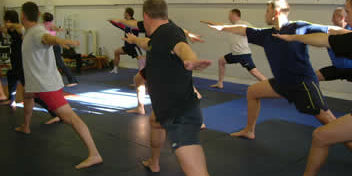BACKGROUND:
I started teaching Iyengar Yoga to the Territorial Support Group (TSG) of the Metropolitan Police force in February 2004. I was invited there as a tentative experiment by Inspector Mark Bird, and although the lessons were regarded initially with some scepticism, they have been very well received.
The work of the TSG is extremely varied; they are deployed over the whole of London, engaged in dealing with large-scale public disorder, rapid entries into premises, crime operations, anti-terrorist activities and surveillance type work. They work long, irregular hours in sometimes stressful, perilous conditions. It was hoped that yoga would help reduce stress levels and increase flexibility.
These police officers have to maintain peak fitness for their particular area of work; they were rated at level one whereas a regular policeman on the street is only required to achieve level three of fitness. I had been tipped off beforehand by their in-house fitness instructor Ryan Williams (also a student) that they would work to their limit and I found this to be the case.
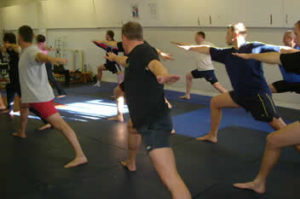
Whereas usually one has to enthuse beginners to get them motivated, this group presented another type of teaching challenge. I almost had to rein in the energy of the group as it had so much power and vitality. The introductory asanas were working their bodies in a way that was different to how most of them had before. There is a delicate balance to be found; one wants to work the pose to get the maximum benefit, and yet not go beyond that point and cause the wrong type of tension in the body.
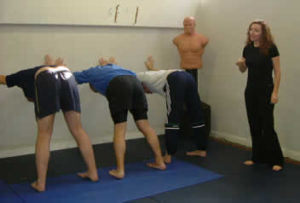
They spend most of their working day establishing and maintaining control; suddenly to be, say, upside down in sarvangasana (for the first time since they were children for most of them) was mildly disorientating and in many respects a humbling experience. They carried it off with great humour and much aplomb. An occasion which illustrates well the dynamics of the group was when I was about to teach baddha konasasa for the first time and I asked them to sit on the floor with their backs to the wall. Although in a large room, they sat almost shoulder to shoulder; there was no room for the knees to bend out to the sides! The sense of esprit de corps is palpable.MY OBJECTIVE:
My objective is to channel their strength and power and wake up the natural intelligence of their bodies. The warrior poses are ideal to this end; they require strength but cannot be achieved with strength alone. On several occasions, when the class were practising the Warrior poses (Virabhadrasana 1,2,and 3), working with full focus as they did, I have been struck by the spectacle before me and have felt that in many ways these students are essentially contemporary warriors, putting themselves at risk for the general good of the community. Strength,in combination with a balanced state of mind, is essential for a wise use of power, making the warrior poses highly appropriate for this group.

The range of flexibility between students is large and Iyengar yoga is excellent in addressing this diversity, as asanas can be adapted to suit the varying needs of each student so that every one gets benefit from each asana, progressing at their own pace. For example, some students can achieve full parsvakonasana whilst others needed to work with the lower elbow on the thigh as the hips were tight.
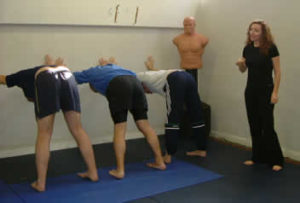
These students work-out in a gym regularly and also have Martial Arts instruction; whereas other exercise systems may ensure a fine physique yoga has evolved over centuries to exercise every muscle, nerve and gland in the body. One develops agility, balance, endurance and great vitality.
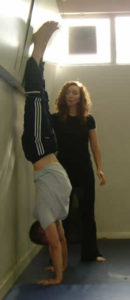
In some cases the police officers’ muscles were sometimes thick-set with limited flexibility. If the muscle cannot stretch enough under pressure then it becomes injured. Their job often demands that they pursue and restrain suspects ; the advantages to being flexible are many, but largely here it reduces the chances of injury significantly as it introduces a wider range of movement.
PRINCIPLES OF YOGA:
One of the principles of yoga is not to seek the fruits of one’s actions. The practice is done for it’s own sake, and though one is striving to do one’s best, one is indifferent to the result. The physical benefits of yoga are a side effect, yet it is these side effects which often draw people to yoga.
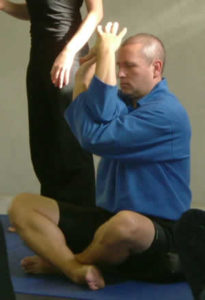
The nature of the work these police officers undertake often puts them in extremely challenging and dangerous situations. As well as describing the benefits of each asana I also explained how each asana has a whole set of characteristics which can be adopted in very simple practical terms to help them: the standing poses bring vitality and correct postural mis-alignment, the sitting poses are calming, supine poses are restful, prone poses energise, twists offer cleansing, inverted poses rejuvenate and bring mental strength, balancing poses brings a feeling of lightness and co-ordination, backbends are exhilarating and jumping poses bring agility.
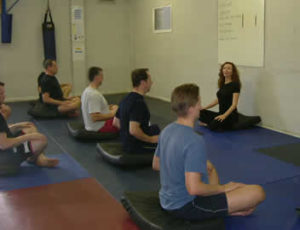 People can come to yoga often for one thing and leave with many others. They may want to cure insomnia but get a glimpse of something deeper and stay long after the insomnia has passed. I personally felt, before the end of my first yoga class, that I was going to be doing yoga for the rest of my life. It is not always so simple. It is only when the asanas have had a chance to permeate the body the deeper value of yoga is experienced. The real importance of the asanas is the way they train and discipline the mind.
People can come to yoga often for one thing and leave with many others. They may want to cure insomnia but get a glimpse of something deeper and stay long after the insomnia has passed. I personally felt, before the end of my first yoga class, that I was going to be doing yoga for the rest of my life. It is not always so simple. It is only when the asanas have had a chance to permeate the body the deeper value of yoga is experienced. The real importance of the asanas is the way they train and discipline the mind.
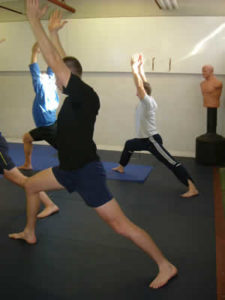
At the very least, the asanas re-align the posture, spreading the work around the body and taking the strain off the over-loaded areas. By simply improving the posture the body works more effectively; weak muscles get strengthened and tight muscles get lengthened thereby reducing their vulnerability to injury. As the tight tissue becomes more flexible any build up of waste products is discharged into the blood stream ready for release.
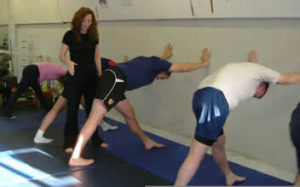
A high proportion of the class have new or old injuries and every one of them has reported an improvement since starting yoga. Again, in such circumstances the asanas are adapted to take the injuries into account. There were many men with inner groin injuries and they all found that supta baddha konasana, with the outer thighs supported, is particularly effective in dealing with this and along with supta virasana, viparita karani, ardhomukha virasana, ideal poses to calm the system after a stressful day.
RESULTS AND ACHIEVEMENTS:
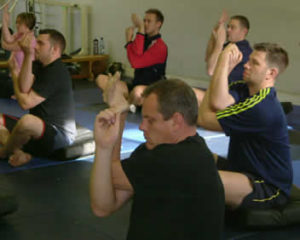
With the regular practice of yoga the negative legacy of the difficult aspect of the police officers’ work gets removed and does not accumulate. They are releasing the stress of the working day, experiencing much needed restorative calm and re-establishing a sense of well-being.
On one particular occasion, after some hip opening poses, one of the men had an uncontrollable fit of laughter. This is simply stress release and not unusual, but when it did not stop for five minutes his Sergeant muttered some dark words to him and he left the room. I continued with the sound of his laughter still audible from the end of the corridor and he returned some five minutes later full of unnecessary apologies. At the next class the “Laughing Policeman” came to me and said that on the night of the last class he had slept better than he had for the last five years.
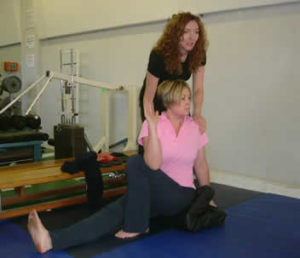
It is this aspect of this teaching which I find most rewarding. I personally believe that the physical body is like a frozen history of one’s life events, both joyous and challenging. If one is regularly subjected to stressful, dangerous situations one needs to be pro-active in taking steps to remove the build up of negative, harmful substances which remain in the system in order to restore equilibrium.
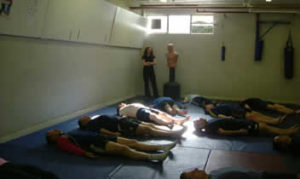
Yoga is the perfect antidote to such a lifestyle; the asanas restore balance and well-being in a way that goes far beyond just physical good health. After a hard day witnessing sometimes the worst of what humanity has to offer, it can make you feel human again. As the body’s natural intelligence awakens one becomes more conscious, one’s perspective broadens and one faces life’s up and downs with an equal mind.
Published in:
Yoga Rahasya Vol 12,No.1 2005
Iyengar Yoga News issue 6 spring 2005
Yoga Magazine March 2005
